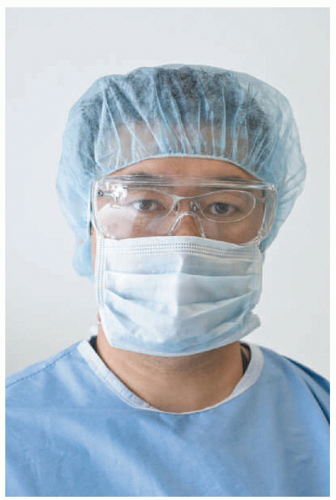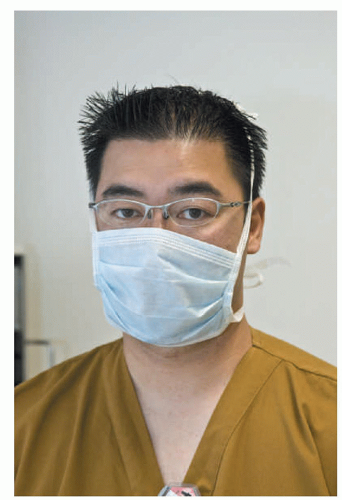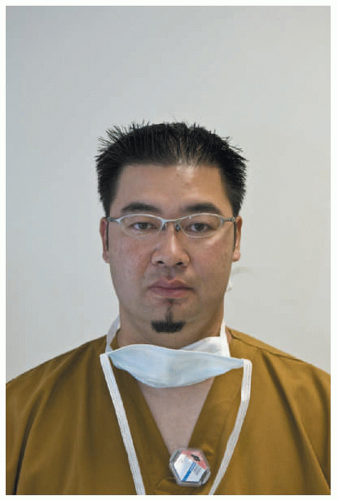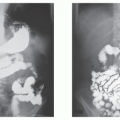Surgical asepsis differs from medical asepsis. Medical asepsis is defined as any practice that helps reduce the number and spread of microorganisms. Surgical asepsis is defined as the complete removal of microorganisms and their spores from the surface of an object. The practice of surgical asepsis begins with cleaning the object in question using the principles of medical asepsis followed by a sterilization process.
Any medical procedure that involves penetration of body tissues (an invasive procedure) requires the use of surgical aseptic technique. This includes major and minor surgical procedures, administration of parenteral medications, invasive imaging procedures, catheterization of the urinary bladder, tracheostomy care, and dressing changes. Skin preparation, including scrubbing and, at times, hair removal, precedes invasive procedures. This prevents contamination of the operative site, thereby reducing the chances of infection. The radiographer may be responsible for the skin preparation in his department and must learn to perform this procedure effectively.
The radiographer will be required to perform diagnostic radiography in the operating room (also called the OR or surgical suite) where they must work without contaminating the sterile fields. Without an understanding of surgical asepsis, this would not be possible. Surgical asepsis is also routinely practiced in the special procedures areas of the imaging department. The radiographer must be able to recognize breaches in aseptic technique and be able to remedy the problem quickly. If contamination is unrecognized, infection may result. It is the duty of all health care workers who participate in procedures requiring the use of surgical asepsis to be able to maintain strict surgical aseptic technique at all times to ensure the well-being of the patient.
ENVIRONMENT AND SURGICAL ASEPSIS
To review, in
Chapter 5 of this text, the methods of microbe transmission are by direct, indirect, vehicle, and airborne routes. Every possible effort is made in the surgical suite and in special procedures areas to protect the patient from infection. Barriers that limit the source of contamination are used for this purpose. All persons who enter the surgical suite or special procedures areas are expected to follow the rules established to maintain these barriers. There are theoretically three zones designated in the surgical suite to help decrease the incidents of infection. They are as follows:
Zone 1: An unrestricted zone—persons may enter in street clothing.
Zone 2: A semirestricted zone—only persons dressed in scrub dress with hair covered and shoes covered may enter.
Zone 3: A restricted zone—only persons wearing scrub dress, shoe covers, and masks are allowed to be present. If a surgical procedure is in progress, the doors to this area are kept closed, and only persons directly involved in the procedure may be present. Those directly involved in the operation are dressed in sterile gowns and sterile gloves. They are often referred to as “being scrubbed.”
Surgical departments have dress and behavior protocols that are strictly enforced. The radiographer who is assigned to work in this area is expected to follow these protocols as designated by Occupational Safety and Health Administration. They are as follows:
1. Shoes must be comfortable with closed heel and toe and not cloth covered. Cloth-covered shoes may allow blood, body fluids, and other liquids to permeate. Cloth-covered shoes will not protect the feet should a heavy object fall on them, such as an image receptor or detector.
2. Personal hygiene must be meticulous. A shower should be taken shortly before beginning a workday in the OR or special procedures area.
3. Jewelry, long or artificial fingernails, and nail polish are prohibited. Jewelry harbors microorganisms as do long, polished, or artificial nails.
4. Any body-piercing jewelry must be removed because it may become loose and fall onto the sterile field.
5. All persons who expect to proceed from the unrestricted zone into the semirestricted zone must go to the dressing area, don a scrub, and tuck the top of the scrubs into the pants or wear a scrub top that fits close to the body.
6. All hair, beards, or mustaches must be covered with a surgical cap and mask. Hair must be confined because it sheds microorganisms with movement (
Fig. 14-1).
7. Shoe covers must be placed over shoes to reduce contamination and to protect shoes from coming in contact with blood and body fluids.
8. Before proceeding into Zone 3, all persons must scrub hands and arms for medical asepsis. It is believed that bare skin may shed microorganisms. In many institutions, all who are not scrubbed for the surgical procedure must wear a scrub jacket to cover bare arms.
9. Before entering a room where a surgical procedure is in progress, a mask must be donned. The masks worn in the OR must be single, high-filtration masks (
Rothrock & McEwen, 2007).
The mask protects the patient from droplets expelled by personnel and protects the health care worker from pathogenic organisms in the surgical environment. The mask must cover the nose and mouth and must not gap. The ties should not cross because it may create venting (
Fig. 14-2). Because they are regarded as highly contaminated, masks
must be worn for only one procedure and then discarded by touching only the ties of the mask and dropping into the receptacle for this purpose. A mask must not be placed around the neck to be worn again (
Fig. 14-3).
Sterile drapes and other equipment and supplies used for sterile procedures must be packaged in a particular manner to be considered safe for use. They are also stored in a particular manner that protects them from contamination. Any break in sterile technique increases the patient’s susceptibility to infection. Those involved in carrying out a sterile procedure must constantly be aware of which areas and articles are sterile. If a sterile article is touched by a nonsterile one, it must be replaced by an article that is sterile. The radiographer must learn correct methods of opening sterile packs and donning sterile gown and gloves.
The use of contaminated instruments or gloves, a wet or damp sterile field, or microorganisms blown onto a surgical site are the most common causes of contamination. Ventilating ducts in the OR must have special filters to prevent dust particles from entering the room. Airflow and humidity must be controlled to prevent static electricity. Doors must remain closed, and traffic into and out of the room must be carefully controlled. When radiographers must use mobile radiographic equipment that is not stationary in the OR suite, they must carefully clean it with a disinfectant solution before bringing it into the OR.
Conversation in the OR or special procedures room is kept to a minimum. The radiographer must always be aware that the surgeon is in charge while performing a surgical or invasive procedure. The environment is often tense as the patient’s life is at risk, and needless conversation is not welcome.
The radiographer or student radiographer whose work involves sterile procedures must develop a sense of responsibility and maintain the highest standards possible when practicing surgical asepsis. The patient’s welfare depends on this.
THE SURGICAL TEAM
The surgical team consists of a variety of staff members who serve the patient before and during surgery. They are as follows:
Surgeon: The physician who plans and performs the surgical procedure and makes surgical decisions.
Surgical assistant: Usually, another surgeon or surgical resident. There may be several assistants if the patient’s surgical needs require this.
Anesthesiologist: A physician with special education in anesthesia who makes the decisions concerning type of anesthesia required.
Nurse anesthetist: A registered nurse who has had special education in anesthesia who administers anesthesia and monitors the anesthetized patient under the supervision of the anesthesiologist.
Circulating nurse: Oversees the safety of the patient and maintains the surgical environment; is attired in scrub suit, cap, mask, and shoe covers, but is not clothed in sterile attire.
Scrub nurse or scrub technician: Dons sterile attire and sets up the sterile fields for the operation. Assists the surgeon by presenting sterile instruments and sterile equipment needed during the procedure.
Radiologic technologist: Present at request of the surgeon to perform imaging procedures; is clothed in a scrub suit, cap, mask, and shoe covers.
Diagnostic imaging is often performed immediately before, during, and after a surgical procedure. Whether a C-arm or a mobile x-ray unit is utilized, the radiographer must be aware of the corridor that he must travel to obtain the image(s). The corridor is between the instrument table and the sterile drapes on the operating table. They must take care not to come in contact with the sterile fields. Each situation varies; however, the maintenance of the sterile fields is mandatory. Often, procedures are planned, and the radiographer is in the OR during the entire surgery. On some occasions, the need for a radiographer is not planned, and the radiographer is called to come to the OR at a moment’s notice. If this is the case, the radiographer goes to the designated dressing area, dons scrub clothes, hair cover, shoe covers, and a mask. The C-arm or mobile imaging equipment must be cleaned as for medical asepsis, before entering the OR.
METHODS OF STERILIZATION AND DISINFECTION
Removal of microorganisms and their spores must be complete, or the article is not sterile. Methods used to attain sterilization depend on the nature of the item to be sterilized. All effective methods of sterilization have advantages and disadvantages. The packaging systems and sterilizing of items used for medical purposes have become a highly specialized field and are described only briefly in this text because it is not within the scope of the radiographer’s practice to perform these tasks.
There are various packaging systems with specific sterilization methods. Whichever sterilization system is used, the radiographer must learn to evaluate the specific sterile packaging system to assure the sterilization integrity of the contents. Articles or surfaces that cannot be sterilized in the OR or special procedures areas must be disinfected. Tables, floors, walls, and equipment used in areas where the patient is to have an invasive procedure are included in this category. Skin around the area to be penetrated is also disinfected. When skin is disinfected, the solutions used are called antiseptics. The term disinfection means that as many microorganisms as possible are eliminated from the surfaces by physical or chemical means. Spores are often not destroyed by disinfection.
Disinfectants are categorized as high level, intermediate level, or low level. This classification depends on their disinfecting ability. Items to be sterilized or disinfected are classified as critical, semicritical, and noncritical based on the risk of infection for the patient (
Rothrock & McEwen, 2007). This classification is called the Spaulding classification system named for its developer, Earle Spaulding.
Table 14-1 lists the disinfectants and their status. The information in this text is not adequate for the radiographer to use if he must incorporate the use of disinfectants into his practice. Further information and precautionary measures must be researched.
Physical methods of disinfecting are boiling in water and ultraviolet irradiation. Boiling may be used as a means of disinfection if no other method is available; however, many spores are able to resist the heat of boiling (212° F or 100° C) for many hours. To increase the effectiveness of boiling, sodium carbonate may be added to the water in quantity to make a 2% solution. If an object is to be disinfected by boiling and sodium carbonate is added to the water, it should be boiled for 15 minutes. If sodium carbonate is not added, boiling time should be 30 minutes.
This is not a practical means of disinfecting for hospital use, because there is no assurance that the ultraviolet has actually come into contact with the microbes, which are constantly in a mobile state because of air currents.
RULES FOR SURGICAL ASEPSIS
The basic rules for surgical aseptic technique apply whenever and wherever the sterile procedure is performed. The radiographer must commit these rules to memory and use them in his own department and elsewhere as necessary.
1. Know which areas and objects are sterile and which are not.
2. If the sterility of an object is questionable, it is not to be considered sterile.
3. Sterile objects and persons must be kept separate from those that are nonsterile.
4. When any item that must be sterile becomes contaminated, the contamination must be remedied immediately.
5. When tabletops are to be used as areas for creating a sterile field, they must be clean, and a sterile drape must be placed over them.


 Get Clinical Tree app for offline access
Get Clinical Tree app for offline access






